Arm's New Cortex-A78 and Cortex-X1 Microarchitectures: An Efficiency and Performance Divergence
by Andrei Frumusanu on May 26, 2020 9:00 AM EST- Posted in
- SoCs
- CPUs
- Arm
- Smartphones
- Mobile
- GPUs
- Cortex
- Cortex A78
- Cortex X1
- Mali G78
The Cortex-A78 Micro-architecture: PPA Focused
The new Cortex-A78 had been on Arm’s roadmaps for a few years now, and we have been expecting the design to represent the smallest generational microarchitectural jump in Arm’s new Austin family. As the third iteration of Arm's Austin core designs, A78 follows the sizable 25-30% IPC improvements that Arm delivered on the Cortex-A76 and A77, which is to say that Arm has already picked a lot of the low-hanging fruit in refining their Austin core.
As the new A78 now finds itself part of a sibling pairing along side the higher performance X1 CPU, we naturally see the biggest focus of this particular microarchitecture being on improving the PPA of the design. Arm’s goals were reasonable performance improvements, balanced with reduced power usage and maintaining or reducing the area of the core.
It’s still an Arm v8.2 CPU, sharing ISA compatibility with the Cortex-A55 CPU for which it is meant to be paired with in a DynamIQ cluster. We see similar scaling possibilities here, with up to 4 cores per DSU, with an L3 cache scaling up to 4MB in Arm’s projected average target designs.
Microarchitectural improvements of the core are found throughout the design. On the front-end, the biggest change has been on the part of the branch predictor, which now is able to process up to two taken branches per cycle. Last year, the Cortex-A77 had introduced as secondary branch execution unit in the back-end, however the actual branch unit on the front-end still only resolved a single branch per cycle.
The A78 is now able to concurrently resolve two predictions per cycle, vastly increasing the throughput on this part of the core and better able to recover from branch mispredictions and resulting pipeline bubbles further downstream in the core. Arm claims their microarchitecture is very branch prediction driven so the improvements here add a lot to the generational improvements of the core. Naturally, the branch predictors themselves have also been improved in terms of their accuracy, which is an ongoing effort with every new generation.
Arm focused on a slew of different aspects of the front-end to improve power efficiency. On the part of the L1I cache, we're now seeing the company offer a 32KB implementation option for vendors, allowing customers to reduce area of the core for a small hit on performance, but with gains in efficiency. Other changes were done to some structures of the branch predictors, where the company downsized some of the low return-on-investment blocks which had a larger cost on area and power, but didn’t have an as large impact on performance.
The Mop cache on the Cortex-A78 remained the same as on the A77, housing up to 1500 already decoded macro-ops. The bandwidth from the front-end to the mid-core is the same as on the A77, with an up to 4-wide instruction decoder and fetching up to 6 instructions from the macro-op cache to the rename stage, bypassing the decoder.
In the mid-core and execution pipelines, most of the work was done in regards to improving the area and power efficiency of the design. We’re now seeing more cases of instruction fusions taking place, which helps not only performance of the core, but also power efficiency as it now uses up less resources for the same amount of work, using less energy.
The issue queues have also seen quite larger changes in their designs. Arm explains that in any OOO-core these are quite power-hungry features, and the designers have made some good power efficiency improvements in these structures, although not detailing any specifics of the changes.
Register renaming structures and register files have also been optimized for efficiency, sometimes seeing a reduction of their sizes. The register files in particular have seen a redesign in the density of the entries they’re able to house, packing in more data in the same amount of space, enabling the designers to reduce the structures’ overall size without reducing their capabilities or performance.
On the re-order-buffer side, although the capacity remains the same at 160 entries, the new A78 improves power efficiency and the density of instructions that can be packed into the buffer, increasing the instructions per unit area of the structure.
Arm has also fine-tuned the out-of-order window size of the A78, actually reducing it in comparison to the A77. The explanation here is that larger window sizes generally do not deliver a good return on investment when scaling up in size, and the goal of the A78 is to maximize efficiency. It’s to be noted that the OOO-window here not solely refers to the ROB which has remained the same size, Arm here employs different buffers, queues, and structures which enable OOO operation, and it’s likely in these blocks where we’re seeing a reduction in capacity.
On the diagram, here we see Arm slightly changing its descriptions on the dispatch stage, disclosing a dispatch bandwidth of 6 macro-ops (Mops) per cycle, whereas last year the company had described the A77 as dispatching 10 µops. The apples-to-apples comparison here is that the new A78 increases the dispatch bandwidth to 12 µops per cycle on the dispatch end, allowing for a wider execution core which houses some new capabilities.
On the integer execution side, the only big addition has been the upgrade of one of the ALUs to a more complex pipeline which now also handles multiplications, essentially doubling the integer MUL bandwidth of the core.
The rest of the execution units have seen very little to no changes this generation, and are pretty much in line with what we’ve already seen in the Cortex-A77. It’s only next year where we expect to see a bigger change in the execution units of Arm’s cores.
On the back-end of the core and the memory subsystem, we actually find some larger changes for performance improvements. The first big change is the addition of a new load AGU which complements the two-existing load/store AGUs. This doesn’t change the store operations executed per cycle, but gives the core a 50% increase in load bandwidth.
The interface bandwidth from the LD/ST queues to the L1D cache has been doubled from 16 bytes per cycle to 32 bytes per cycle, and the core’s interfaces to the L2 has also been doubled up in terms of both its read and write bandwidth.
Arm seemingly already has some of the most advanced prefetchers in the industry, and here they claim the A78 further improves the designs both in terms of their memory area coverage, accuracy and timeliness. Timeliness here refers to their quick latching on onto emerging patterns and bringing in the data into the lower caches as fast as possible. You also don’t watch the prefetchers to kick in too early or too late, such as needlessly prefetching data that’s not going to be used for some time.
Much like the L1I cache, the A78 now also offers an 32KB L1D option that gives vendors the choice to configure a smaller core setup. The L2 TLB has also been reduced from 1280 to 1024 pages – this essentially improves the power efficiency of the structure whilst still retaining enough entries to allow for complete coverage of a 4MB L3 cache, still minimizing access latency in that regard.
Overall, the Cortex-A78’s microarchitectural disclosures might sound surprising if the core were to be presented in a vacuum, as we’re seeing quite a lot of mentions of reduced structure sizes and overall compromises being made in order to maximize energy efficiency. Naturally this makes sense given that the Cortex-X1 focuses on performance…


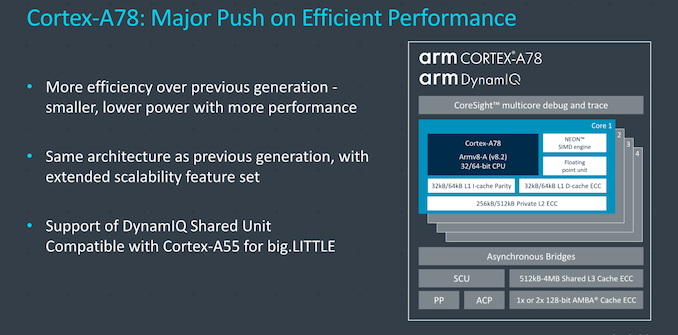
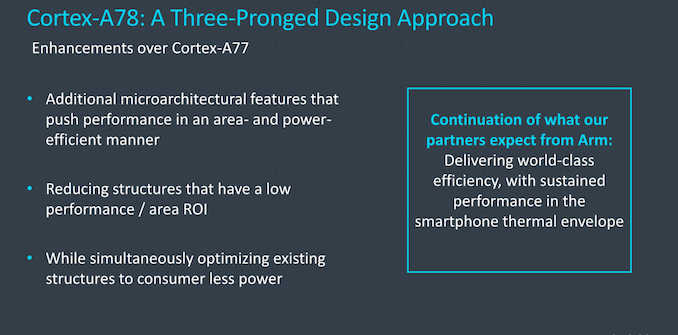
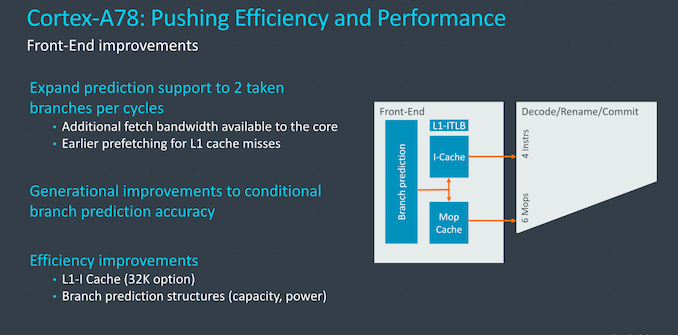
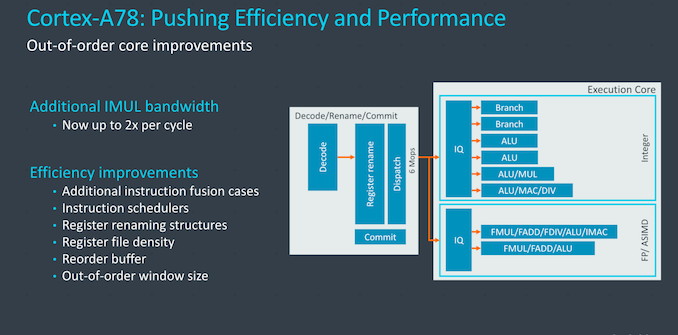
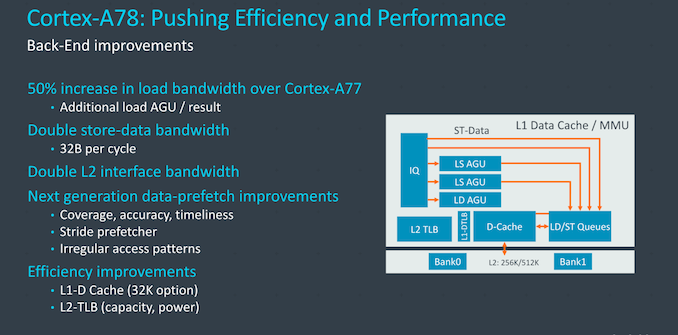








192 Comments
View All Comments
Quantumz0d - Tuesday, May 26, 2020 - link
First things first, so what's the cost here of the new X1 vs the 78, we already have $1000 for the smartphone planned obsolescence and now this is next level uber crazy alien tech is going to make them go for obscene $2000 non user replaceable battery junk tech gadgets ?Going wider and 3GHz I don't know maybe maybenot, Zen doesn't clock higher because of it's wider arch from what I saw and the 7N limitations. Even Intel is going wider next, which is going to get hit in the pure clockspeed.
And next, this is hilarious - " they should outright panic at these figures if they actually materialize – and I do expect them to materialize"
Outright panic ? - Let's look at facts 95% Intel, 4.5% AMD from Q4 2019 - Server Marketshare & wonder where does ARM sit here to make both Intel and AMD "Panic".
ARM always about custom this custom that BS, Every single thing needs to be made custom for that crappy ARM part and the LGA socket system is not even a standard for these ARM Server CPUs and x86 is all about the Sockets and in the Consumer space mobile and DIY it doesn't exist, thanks to the Software which is a bigger driving force behind any product in this specturm, esp everyone knows Qualcomm's ever marketed (by Cloudflare) Centriq 2400 10nm Server CPU got deleted from it's existence and even stopped pursuing such goals, where they even put full Kryo SD820's full custom engineers on it and even the guy who was spearheading also moved on.
I will wait to see what's going to happen to the ever bashed x86 by the ARM superiority or the Apple A series Alien processors.
ah06 - Wednesday, May 27, 2020 - link
Those are the facts as of now yes. But the rest of the post sounds like someone about to get disrupted. The bulk of x86 vendor profits come from laptops, specifically general use thin, light and cheap laptops, those are about to be disrupted. Which is to say that in 5 years time, x86 on laptops will cease to exist in any meaningful way. Desktops/Enthusiast parts are not financially relevant to any of these companies.Drake H. - Wednesday, May 27, 2020 - link
Nah. The servers are the pot of gold, where profit margins are really high.You will soon see that ARM will have its small space, but it does not pose a danger to the duopolio x86, something very complex will be coming and everything is already sealed with patents.
Drake H. - Wednesday, May 27, 2020 - link
https://www.phoronix.com/scan.php?page=article&... Here's an example of how ARM outperforms x86. XDYojimbo - Tuesday, May 26, 2020 - link
Hera hated Hercules.vladx - Tuesday, May 26, 2020 - link
We need Zeus next.jaju123 - Tuesday, May 26, 2020 - link
Disappointed that there's no replacement for the ancient a55 yetKamen Rider Blade - Tuesday, May 26, 2020 - link
I concur, A55/A78 still on ARMv8.2-AARM is already on ARMv8.6-A
And there are already announced new CPU instructions coming down the pipe.
https://en.wikipedia.org/wiki/ARM_architecture#Fut...
In May 2019, ARM announced their upcoming Scalable Vector Extension 2 (SVE2) and Transactional Memory Extension (TME).
Raqia - Tuesday, May 26, 2020 - link
It's an interesting drop for this year's ARM tech day: I imagine A78 plans were nebulous when the A76 dropped, and they may have downscaled what is now called the A78 and upscaled what's now the X1. There will likely be a 9cx part for Windows on ARM that can leverage the higher end cores and larger caches very well, but really looking forward to Matterhorn and their new smaller core design which will be very impactful for mobile performance.StormyParis - Tuesday, May 26, 2020 - link
To me, these stories are always kind of exciting and kind of pointless. I'm no longer buying flagships, and even at the low/mid-range, it's been years since I've had, or have heard, a complaint about performance.The apps we use haven't changed in 5 years. Maybe some games, but VR never took off, and InstaGram/Twitter/Maps/FB... are the same. "As long as it has a Core A7x, it is Delightful." Hopefully the X program will help ARM get into consoles, laptops and desktop, and hopefully Android will start supporting that... even today, it's more of an Android problem than an ARM problem. Maybe Windows will fix what Google fumbled.